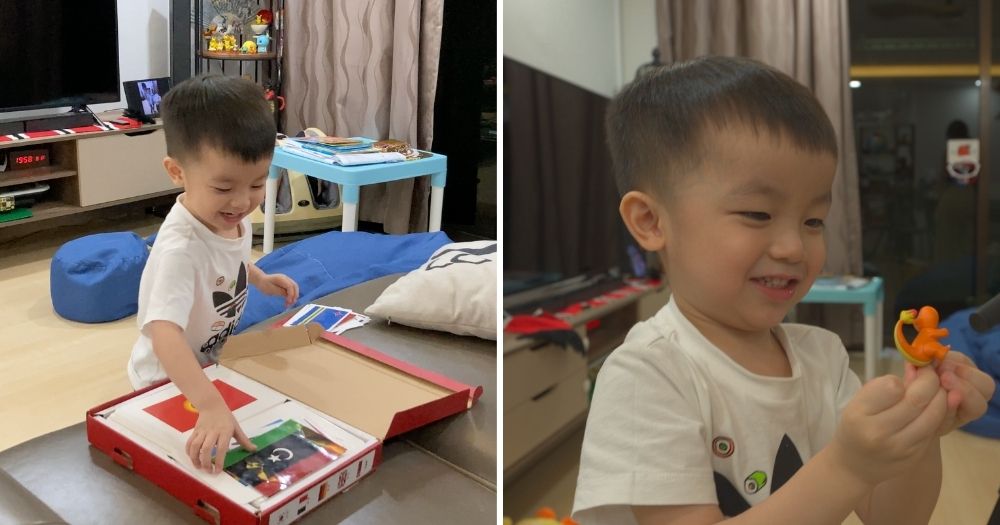Follow us on Telegram for the latest updates: https://t.me/mothershipsg
PERSPECTIVES: "We didn’t force him — it just came naturally. Now it's the other way around — he forces us to teach him."
On Mar. 12, two-year-and-11-month-old Ezac Lim Ee Zher officially became the youngest person in Singapore to recognise the flags of 200 countries and territories, naming them all in a mere seven minutes and 33 seconds.
But Ezac's incredible feat didn't come out of his parents pushing him excessively to excel, his father Lim Li Wei reveals.
In fact, it's actually the opposite: Ezac's passion for flags and maps is so self-driven that he insists that his parents help him learn more.
We visited Ezac, Lim, and Ezac's mother Wong Chai Ling at their home to find out more about the bright toddler, his passion for maps, and how he's really just an enthusiastic, playful toddler.
I have to be honest — When I first heard about Ezac Lim, I was sceptical.
I struggled to wrap my head around the fact that a not-even-three-year-old kid could be capable of such a feat. Perhaps, I thought, this could be one of those cases of smart kids with overbearing parents who push them to the extreme.
I couldn’t have been more wrong.
When we arrive at the flat on a Wednesday evening, the elder Lim opens the door. Ezac is not far behind his father, beaming, bouncing, and full of energy.
We spend the first couple of minutes setting up our cameras and chatting casually with Lim and Wong.
In the meantime, Ezac grabs his box of flag flashcards, completely unprompted, and plops the box onto the couch.
He begins removing the cards from the box and shouting out the name of each country or region gleefully.
"Macau! Austria! Puerto Rico! Montenegro! Aruba! Libya! South Sudan! Greenland! Hong Kong! American Samoa! Guam!"
Started with a flag poster
So how did Ezac even get started with recognising so many flags?
It was a natural progression, Lim explains. Ezac had already learned his ABCs, numbers, colours, and shapes by the time he was two years old, so Lim and Wong were considering what else they could teach him.
They decided to try teaching him country names and some flags.
Ezac's interest has only grown since then.
During a trip to Malaysia in December 2021, Ezac first realised that flags were real-life things:
"At that time, he only could recognise I think a few countries’ flags. And he had seen one actual country flag, which was Singapore. Then when we were in Malaysia, he saw the actual Malaysia flag. Then he realised, 'Oh, different countries have different flags?"
When they returned to Singapore in January this year, Lim and Wong were at a bookstore when they came across a poster of country flags. Lim says:
“At the time, I thought it's quite impossible for him to learn all these, and thought it was a waste of money. [Wong] convinced me actually, because anyway just S$5, just try to see if he can pick this up.”
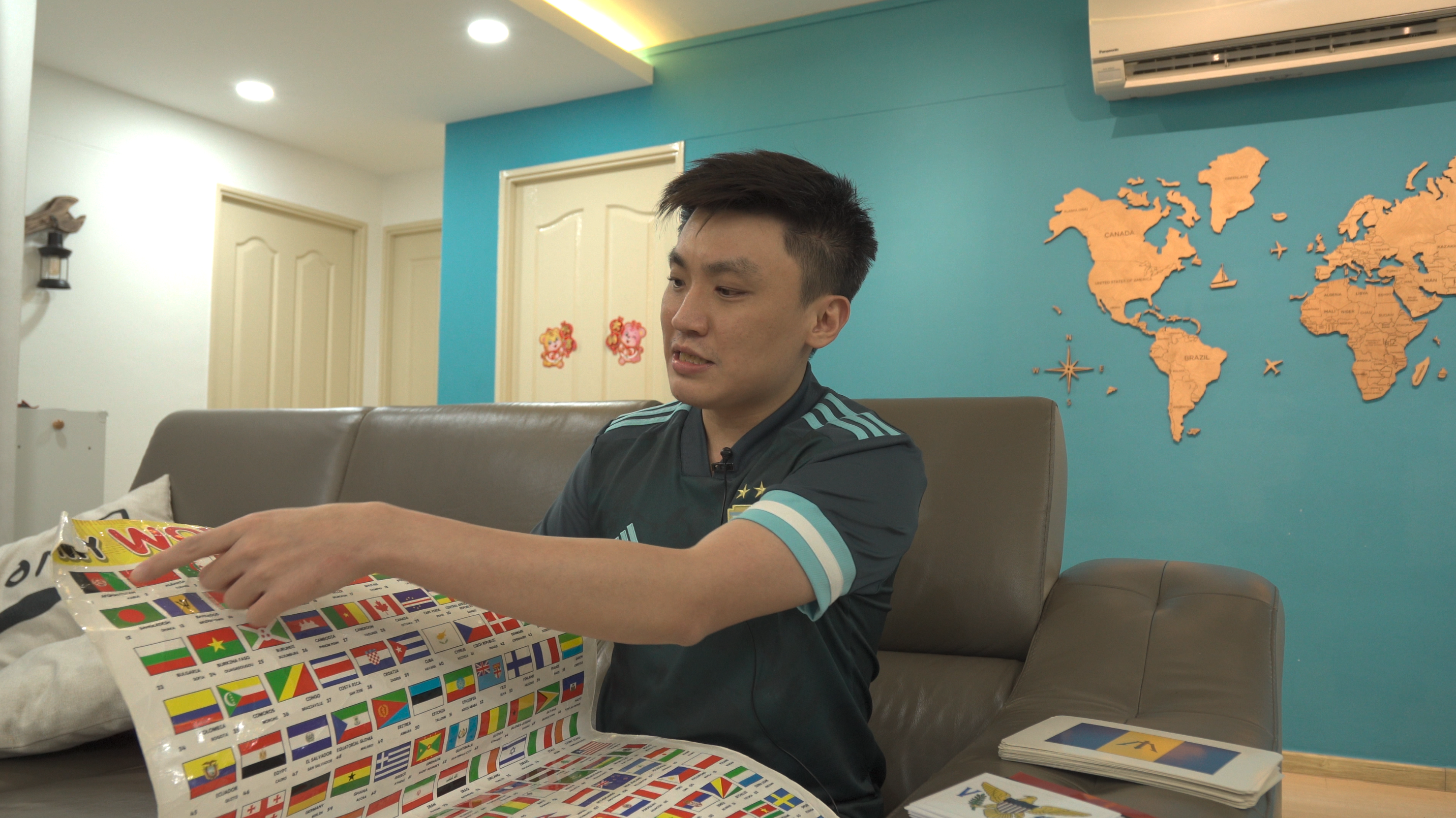 Photo by Hor Teng Teng.
Photo by Hor Teng Teng.
Once they brought the poster home, though, Ezac immediately took to it.
“He can memorise and recognise the colours, patterns very accurately, like with photographic memory recall. So, he just start from A to Z. And I think within a very short time, he learned all these things already — I think around age two years and eight or nine months?”
Lim and Wong then decided to try to see if Ezac could recognise the flags outside of the A to Z order they were listed in on the poster.
“We just tested him with some random photos from from the internet and he could actually recognise the flags.
[The poster] actually didn’t cover all the countries, so after that we tried to use some flashcards and we searched online images to try to teach him all the countries and then he picked them up very quickly.”
Recognising countries on a map
Soon, Ezac’s interest in countries expanded to identifying the countries on a wooden map mounted on the family’s living room wall, which has been there since before Ezac was born.
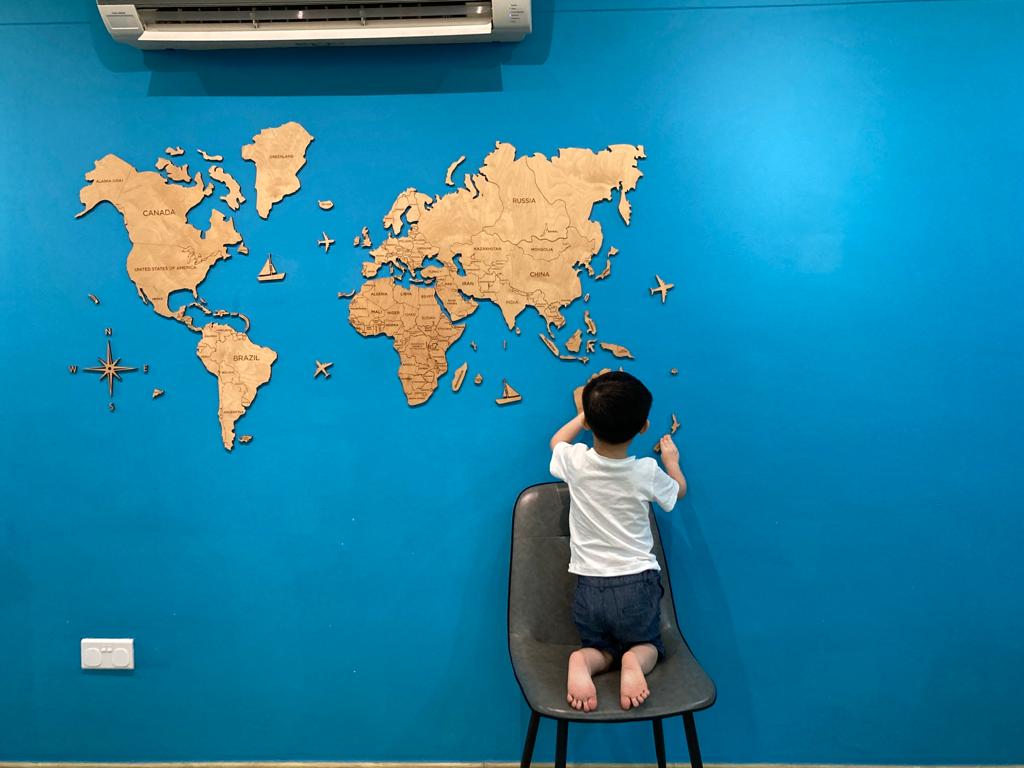 The family moved into their house a few months before Ezac was born. This wall was painted blue to represent the ocean. Photo by Jane Zhang.
The family moved into their house a few months before Ezac was born. This wall was painted blue to represent the ocean. Photo by Jane Zhang.
“After he was born, we would just hold him and tell him for fun, ‘Where is this? This is Singapore, this is China, this is USA, something like that.’
Slowly, when he start to talk, he feels like he has the interest to also recognise the name, like ‘Brazil’, and he would point to Brazil, ‘Russia’, and he would point to Russia. We taught him, ‘Russia 大大! Russia is very big.’”
After teaching Ezac to recognise the big countries on the map, he slowly began recognising the smaller countries as well.
"I would say now he can recognise like 99 per cent of the countries accurately. Maybe one or two countries in Europe because they are too close or their shape is too similar, that he might confuse them — like say, Czech Republic and Austria are very close to each other and the shape is very similar. The size is also very similar.
Otherwise, he can do almost all of them. I wouldn't say it's a ‘training’. It’s just... since he’s interested, I teach him, guide him, mentor him."
Not forcing him; rather, the other way around
The entire time Lim is telling us about Ezac’s interests, Ezac is off to the side with Wong playing a game on Lim’s phone about... you guessed it, flags.
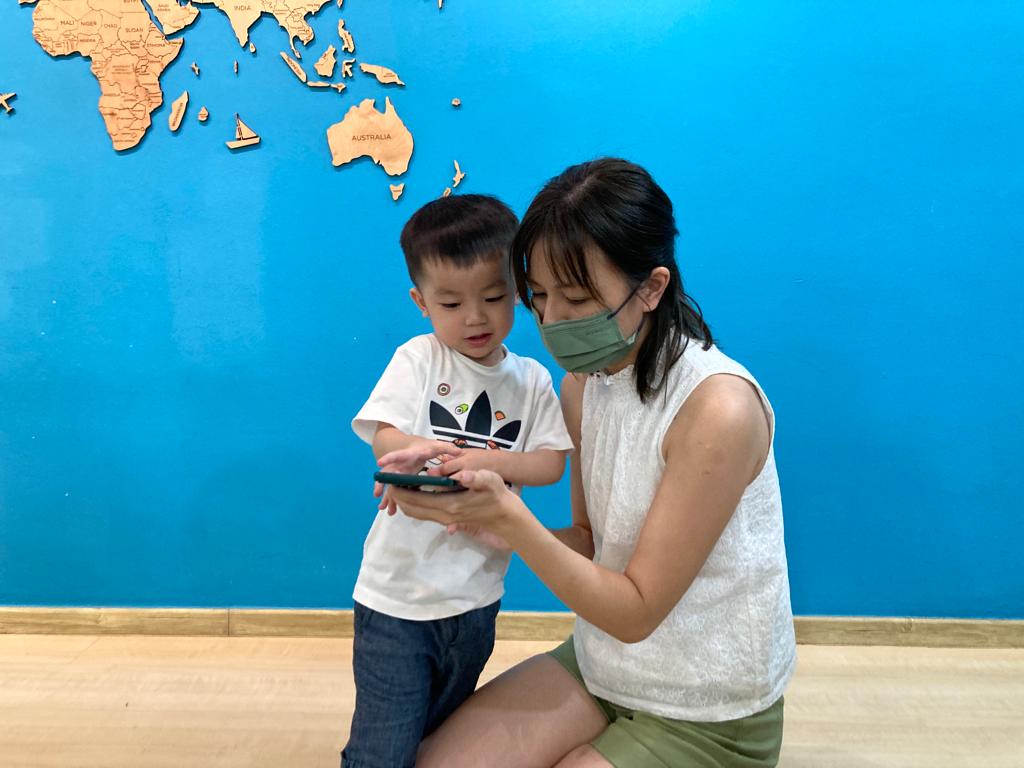 Photo by Jane Zhang.
Photo by Jane Zhang.
The game tests your ability to identify different countries' flags, and Ezac (with the help of Wong) would tap the letters shown on screen to spell out the country’s name.
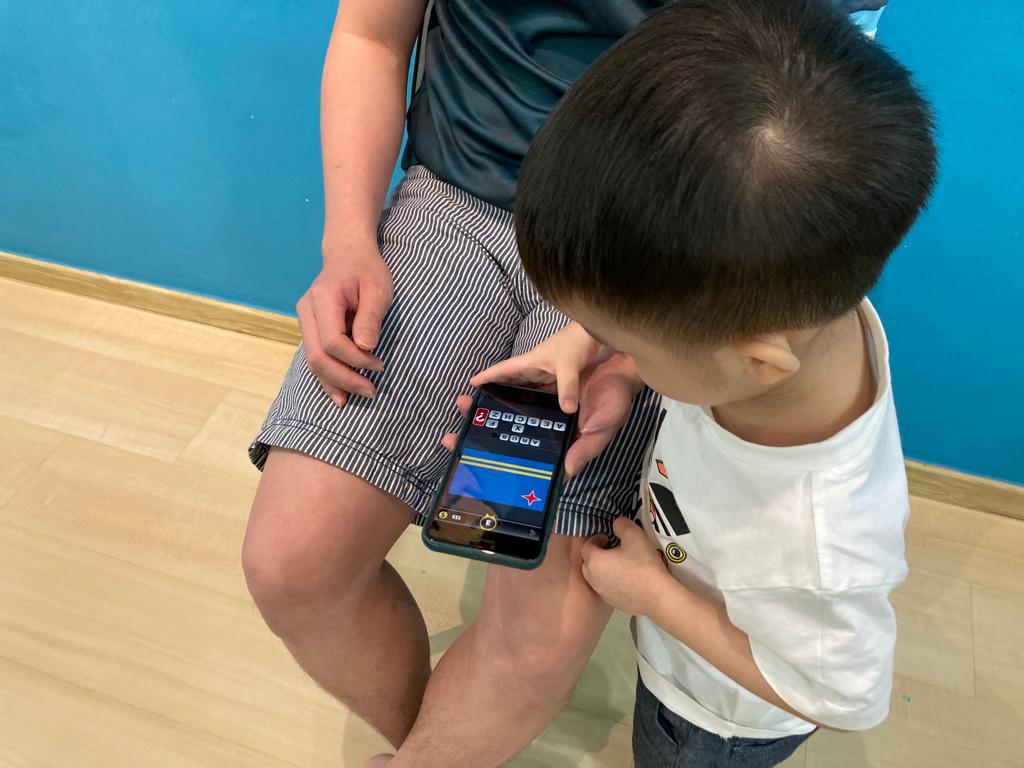 Photo by Jane Zhang.
Photo by Jane Zhang.
“Ezac can spell???” I ask incredulously.
Lim explains that Ezac has learned to spell the first few letters of some countries, but not their full names.
I don’t know much about raising kids, but I’m pretty sure that most almost-three-year-olds can barely read (though Ezac can, by the way), much less spell even the first few letters of a word.
How did all of this happen? Are Lim and Wong really the overbearing parents that I suspected they were, who force their son to excel in every way?
As I sit there in their living room and see Ezac excitedly bounce from flag flash cards to the world map to his father’s phone, shouting out country names with such joy and childlike happiness, it’s clear that this isn’t the case.
Lim explains:
“We didn’t force him — it just came naturally. Now it's the other way around — he forces us to teach him.
Like every time when he comes back from school, he will want me to play the map games with him, like show him the flag and then he tells me what is it. And show him the empty map and then I spell out the country name then he will point where is it.”
Laughing, he adds that Ezac’s passion for countries has actually become a bit of an issue:
"I think he's at the stage [where] he'll try to always find something to do to drag [back his bedtime] then one of them is like, he will bring the chair over [to the map] and then he will start from Afghanistan — the first country [starting with] A. Then all the way to Zimbabwe.
One by one, he will point out where is it, where is it, where is it? He must finish this, otherwise, he don't want to sleep.”
Just a regular almost-3-year-old
When I came into this interview, my goal had been to hear from the little man himself.
I had prepared a list of questions for Ezac, like what his favourite flag is, what countries he wants to visit, and what he wants to be when he grows up.
I was a bit worried these questions might be too complicated for a three-year-old to answer, but I also knew that Ezac didn’t seem like most three-year-olds.
After all, can most three-year-olds name over 200 world flags?
But I soon realise that Ezac is indeed like many other three-year-olds — more interested in his toys and what he wants to do than answering questions from some boring adult.
“How old are you?” I ask him, sitting on the ground near him.
He spends a few seconds squirming and getting distracted before Lim asks him, “How many years old are you?”
“Three years old! Three years old!” he exclaims.
He quickly shifts his attention again, though, badgering his dad for his phone to get back into the flag guessing game.
And like any other kid, he doesn’t know everything, contrary to how it may seem.
At one point, Ezac picks up the South African flag from his flashcard box.
“Africa! Africa!” Ezac exclaims.
“South Africa,” Lim reminds him.
“AFRICA!” Ezac insists enthusiastically.
After all, what toddler isn't a little stubborn, especially when it comes to something they clearly like a lot?
But there’s more to Ezac than just liking flags, Lim assures us with a laugh:
“[For him] it’s not just flags! He’s not just a boring kid. He likes Pokémon, he likes cars, all those toys.”
Later, when I ask Ezac what his favourite toy is, he runs over to his Pokémon collection and brings us Charmander and Bulbasaur.
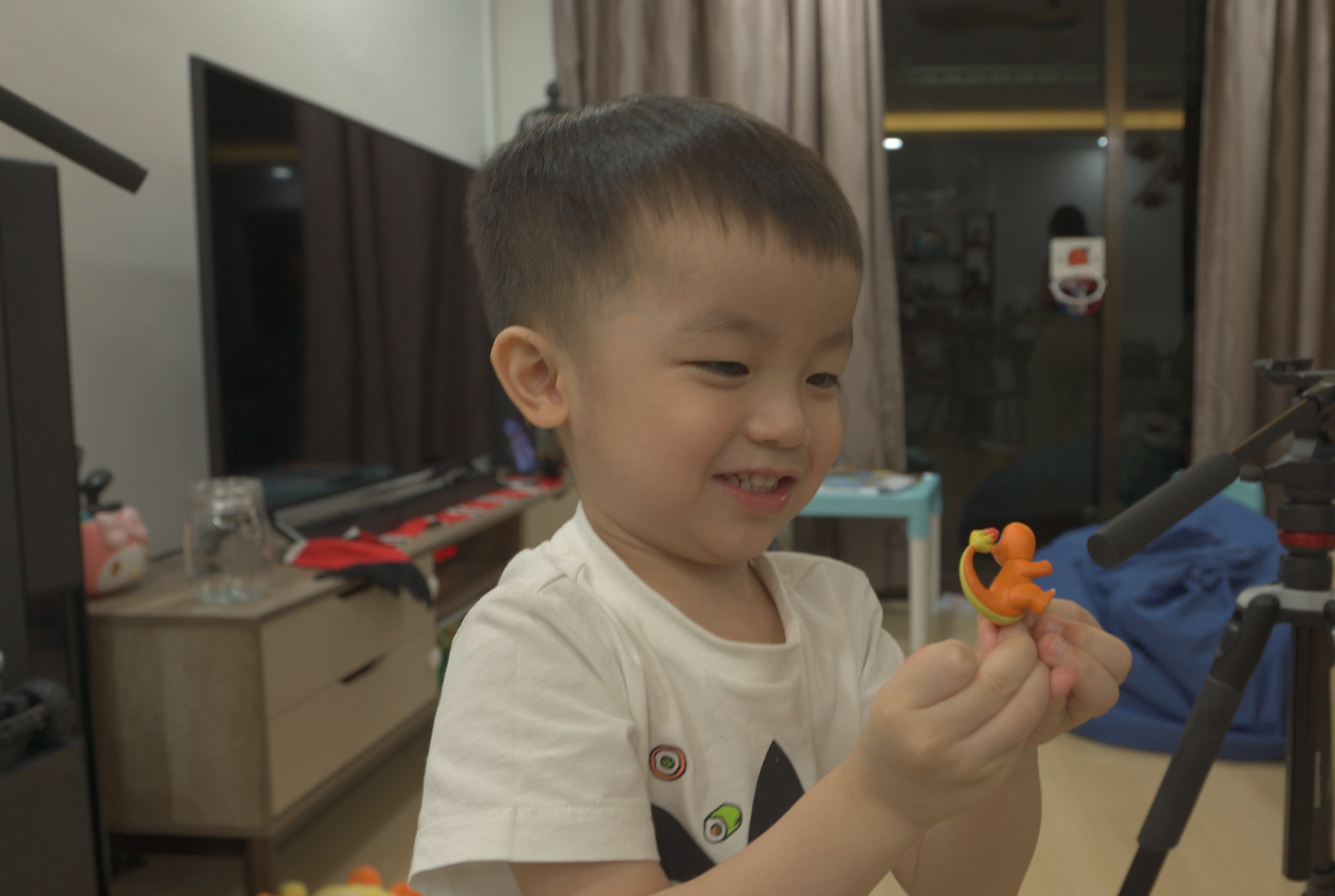 Photo by Hor Teng Teng.
Photo by Hor Teng Teng.
“Bulbasaur!” he states matter-of-factly as he holds up the grass Pokémon.
Brandishing Charmander, he shouts, “Dragonman!”
“Charmander,” Lim corrects him gently.
“DRAGONMAN!”, Ezac retorts.
Hope he can grow up happy without extra burden or expectations
As we get ready to wrap up for the night, Ezac is engrossed in playing with his toys, a reminder that although he can name more flags than many adults, he’s really just like any other toddler.
 Photo by Jane Zhang.
Photo by Jane Zhang.
Lim emphasises:
"I just want to say I don’t think Ezac is a genius or special, he’s just a kid with good memory and happened to develop a keen interest in world map and flags.
[...] Ultimately we just want him to grow up happily like other kids without additional burden or expectations."
In fact, he has absolutely no qualms with — and in fact, hopes for — another bright kid bypassing Ezac's impressive achievement:
"I hope someday a younger kid from Singapore can beat him and even beat the world record. But maybe if a two-year-old can beat Ezac’s record, I’m very happy for them.
And I hope that he can inspire more parents to want to teach their kids about recognising flags."
Here's our video of Ezac in action:
Follow and listen to our podcast here
Top photos by Jane Zhang and Hor Teng Teng. Some quotes have been edited for clarity.
If you like what you read, follow us on Facebook, Instagram, Twitter and Telegram to get the latest updates.
